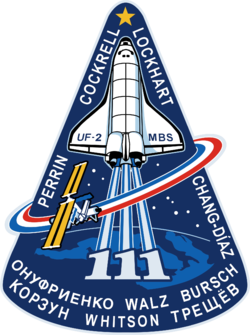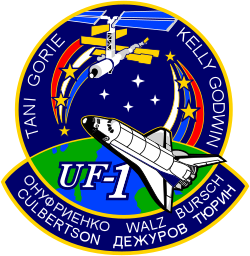Daniel Bursch
| Daniel Wheeler Bursch | |
|---|---|
 | |
| americký astronaut | |
| Státní příslušnost | USA |
| Datum narození | 25. července 1957 (67 let) |
| Místo narození | |
| Jiné zaměstnání | inženýr |
| Čas ve vesmíru | 226 dní 22 hodin 16 minut |
| Kosmonaut od | 1990 |
| Mise | STS-51, STS-68, STS-77, STS-108, Expedice 4, STS-111 |
| Znaky misí | |
| Kosmonaut do | 2005 |
| Některá data mohou pocházet z datové položky. | |
Daniel Wheeler Bursch (* 25. červenec 1957 Bristol) je americký astronaut, který absolvoval čtyři lety na oběžnou dráhu Země a půl roku pracoval na kosmické stanici ISS. Byl v pořadí 299. člověk ve vesmíru a v kosmu strávil celkem 226 dní. V roce 2002 dvakrát vystoupil ve skafandru vně stanice (tzv. výstup EVA). Používá přezdívku Dan.
Životopis
Středoškolské studium zakončil na Vestal Senior High School v roce 1975 a nastoupil na US Naval Academy. Obor fyziky absolvoval roku 1979, pokračoval pak po letech na stejné škole postgraduálním studiem zdárně ukončeném roku 1991. Mimo to v roce 1984 absolvoval školu a výcvik testovacích vojenských pilotů, když již předtím působil i jako letec bombardovacích letadel. Pak v armádě působil jako instruktážní pilot na základně Patuxent River. V roce 1987 se stal operačním důstojníkem letectva a 17. ledna 1990 se zapojil do NASA. Absolvoval nezbytný výcvik k Houstonu a v letech 1993 až 2002 byl čtyřikrát ve vesmíru. Je ženatý a má několik dětí.
Lety do vesmíru
Poprvé letěl v září 1993, kdy mu bylo 36 let, v raketoplánu Discovery. Jednalo se o misi STS-51, posádka byla pětičlenná a během 10denního letu vypustila dvě družice, telekomunikační ACTS, vědeckou Astro-SPAS. Start i přistání byly z kosmodromu na Mysu Canaveral, Florida. Mise byla katalogizována v COSPAR pod označením 1993-058A.
Další lety absolvoval v raketoplánu Endeavour. Už rok po prvním svém letu startoval z Mysu Canaveral na oběžnou dráhu Země znovu, tentokrát se jednalo o misi STS-68, katalogizovanou v COSPAR 1994-062A s šestičlennou posádkou. Jedenáctidenní program byl zaměřen na ekologii Země. Přistání bylo na kalifornské základně Edwards v (Kalifornii – Mohavská poušť)
Potřetí letěl s raketoplánem na jaře roku 1996. Jednalo se o misi STS-77 (COSPAR 1996-032A) s šestičlennou mezinárodní posádkou, která odstartovala z kosmodromu Mysu Canaveral na Floridě. Na palubě měli vědeckou laboratoř Spacelab a během mise vypustili na oběžnou dráhu družici Spartan 207-IAE, kterou později zas zachytili a odvezli zpátky na Zem. Vypustili pak družici další PAMS-STU, která na oběžné dráze zůstala. Přistáli po 10 dnech letu na Floridě.
Čtvrtý let absolvoval jako člen Expedice 4. Na mezinárodní stanici ISS odletěl v prosinci 2002 v raketoplánu Endeavour (STS-108, COSPAR 2002-028A). Na palubě bylo sedm astronautů, tři z nich na stanici zůstali. Na stanici dovezli zásobovací modul Raffaello. Raketoplán pak odvezl členy předchozí Expedice 3 zpátky na Zem, Bursch zůstal ve službě, spolu s ním Rus Jurij Onufrienko a Carl Walz. Během půlročního pobytu přijali dvě zásobovací lodě Progress M1, raketoplán STS-110 a Sojuz TM-34. V červnu 2002 je na oběžné dráze vystřídali kolegové z Expedice 5, Daniel Bursch se vrátil s raketoplánem Endeavour v misi označené STS-111 domů.
Lety v kostce
- STS-51 Discovery – start 12. září 1993, přistání 22. září 1993
- STS-68 Endeavour – start 30. září 1994, přistání 11. říjen 1994
- STS-77 Endeavour – start 19. květen 1996, přistání 29. květen 1996
- STS-108, ISS, STS-111 Endeavour – start 5. prosinec 2001, 19. červen 2002
Externí odkazy
 Obrázky, zvuky či videa k tématu Daniel Bursch na Wikimedia Commons
Obrázky, zvuky či videa k tématu Daniel Bursch na Wikimedia Commons - Osobní stránka na webu MEK
- Mise STS-51
- Mise STS-77
- Mise STS-108
- Expedice 4
- Mise STS-111
- Osobní stránka na webu Kosmo
Média použitá na této stránce
STS111-S-001 --- The STS-111 patch symbolizes the hardware, people, and partner nations that contribute to the flight. The Space Shuttle rises on the plume of the Astronaut Office symbol, carrying the Canadian Mobile Base System (MBS) for installation while docked to the International Space Station (ISS). The mission is named UF-2 for ISS Utilization Flight number two. The ISS orbit completes the Astronaut Office symbol and is colored red, white, and blue to represent the flags of the United States, Russia, France, and Costa Rica. The Earth background shows Italy, which contributes the Multi Purpose Logistics Module (MPLM) used on this flight to re-supply ISS. The ten stars in the sky represent the ten astronauts and cosmonauts on orbit during the flight, and the star at the top of the patch represents the Johnson Space Center, in the state of Texas, from which the flight is managed. The names of the STS-111 crew border the upper part of the patch, and the Expedition Five (going up) and Expedition Four (coming down) crews’ names form the bottom of the patch. The NASA insignia design for Shuttle flights is reserved for use by the astronauts and for other official use as the NASA Administrator may authorize. Public availability has been approved only in the forms of illustrations by the various news media. When and if there is any change in this policy, which is not anticipated, the change will be publicly announced.
This is the mission patch of STS-108. Space Shuttle Endeavour is seen approaching the International Space Station. Two astronaut symbols represent the crew commanders of both ISS expeditions. The ascending one represents cosmonaut Yury Onufriyenko of Russia. (The ascending astronaut symbol shows a flag of Russia.) The descending astronaut symbol represents Frank Culbertson of the USA. This represents crew rotation, as three stars are depicted on the symbols. The space shuttle crew members are depicted along the border while the ISS crews are depicted along the chevron on the border of the patch.
- This is the insignia for the STS-108 mission, which marks a major milestone in the assembly of the International Space Station (ISS) as the first designated Utilization Flight, UF-1. The crew of Endeavour will bring the Expedition Four crew to ISS and return the Expedition Three crew to Earth. Endeavour will also launch with a Multi-Purpose Logistics Module (MPLM) that will be berthed to ISS and unloaded. The MPLM will be returned to Endeavour for the trip home and used again on a later flight. The crew patch depicts Endeavour and the ISS in the configuration at the time of arrival and docking. The Station is shown viewed along the direction of flight as will be seen by the Shuttle crew during their final approach and docking along the X-axis. The three ribbons and stars on the left side of the patch signify the returning Expedition Three crew. The red, white and blue order of the ribbons represents the American commander for that mission. The three ribbons and stars on the right depict the arriving Expedition Four crew. The white, blue, red order of the Expedition Four ribbon matches the color of the Russian flag and signifies that the commander of Expedition Four is a Russian cosmonaut. Each white star in the center of the patch represents the four Endeavour crew members. The names of the four astronauts who will crew Endeavour are shown along the top border of the patch. The three astronauts and three cosmonauts of the two expedition crews are shown on the chevron at the bottom of the patch.
The STS-77 crew patch displays the Shuttle Endeavour in the lower left and its reflection within the tripod and concave parabolic mirror of the SPARTAN Inflatable Antenna Experiment (IAE). The center leg of the tripod also delineates the top of the Spacehab's shape, the rest of which is outlined in gold just inside the red perimeter. The Spacehab was carried in the payload bay and housed the Commercial Float Zone Furnace (CFZF). Also depicted within the confines of the IAE mirror are the mission's rendezvous operations with the Passive Aerodynamically-Stabilized Magnetically-Damped satellite (PAM/STU) appears as a bright six-pointed star-like reflection of the sun on the edge of the mirror with Endeavour in position to track it. The sunlight on the mirror's edge, which also appears as an orbital sunset, is located over Goddard Space Flight Center, the development facility for the SPARTAN/IAE and Technology Experiments Advancing Missions in Space (TEAMS) experiments. The reflection of the Earth is oriented to show the individual countries of the crew as well as the ocean which Captain Cook explored in the original Endeavour. The mission number 77 is featured as twin stylized chevrons and an orbiting satellite as adapted from NASA's logo. The stars at the top are arranged as seen in the northern sky in the vicinity of the constellation Ursa Minor. The field of 11 stars represents both the TEAMS cluster of experiments (the four antennae of GPS Attitude and Navigation Experiment (GANE), the single canister of Liquid Metal Thermal Experiment (LMTE), the three canisters of Vented Tank Resupply Experiment (VTRE), and the three canisters of PAM/STU) and the 11th flight of Endeavour. The constellation at the right shows the fourth flight of Spacehab Experiments.
Astronaut Daniel W. Bursch will serve as a flight engineer on Expedition Four at the end of 2001 and the first part of 2002.
STS-68 Mission Insignia
STS-51 Patch
The International Space Station (ISS) Expedition Four crew patch has an overall diamond shape, showing the "diamond in the rough" configuration of the Station during expedition four. The red hexagonal shape with stylized American and Russian flags represents the cross-sectional view of the S0 truss segment, which the crew will attach to the U.S. Lab Destiny. The persistent Sun shining on the Earth and Station represents the constant challenges that the crew and ground support team will face every day while operating the International Space Station, while shedding new light through daily research. The green portion of the Earth represents the fourth color in the visible spectrum and the black void of space represents humankind's constant quest to explore the unknown.







